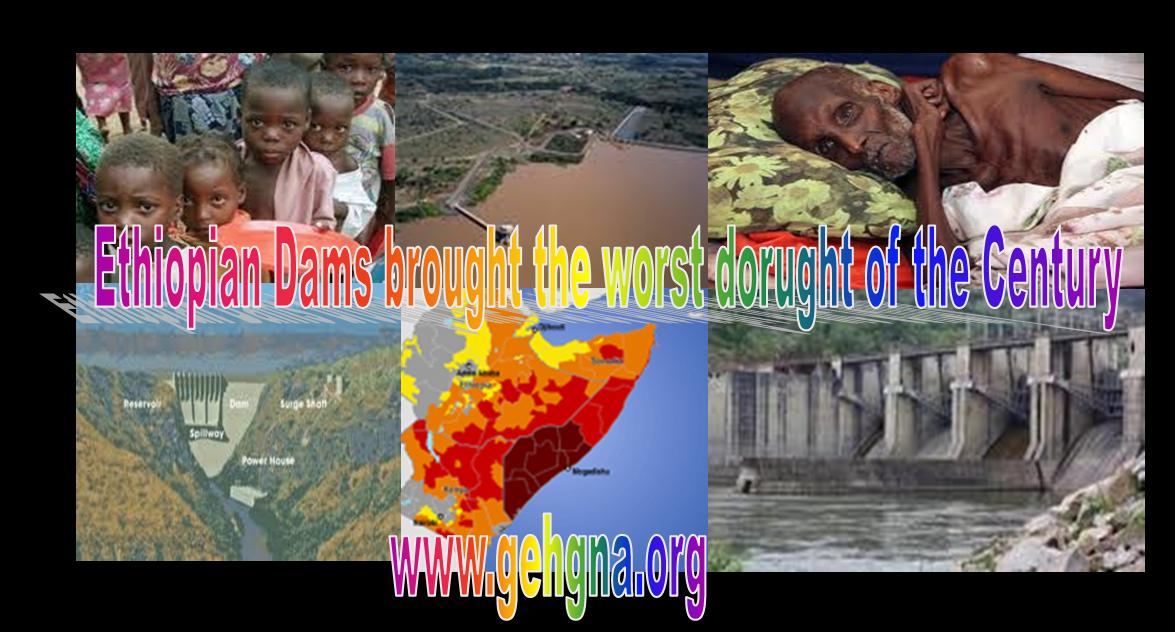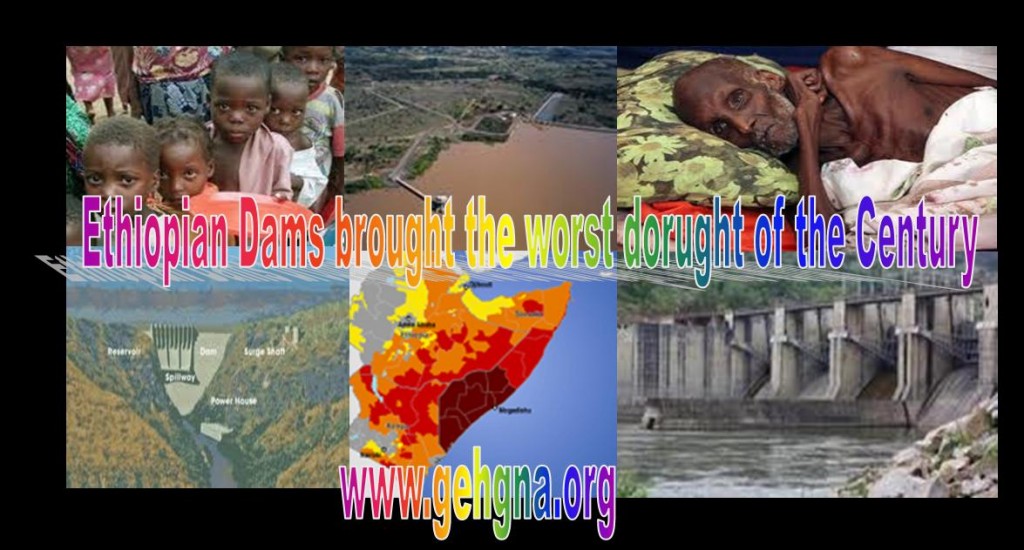The famine in the Horn of Africa used be blame mainly for the drought caused by the global climate change ignoring the pricipla culprit the the dictatorial regime. In the past the same has brought regime change in country of hunger Ethiopia two times, that of the Negus in 1974 and the Derg Military Junta in 1991. As the French says there is no two without three, we expecting a regime change in the country since all conditions are meeting as those of the last two experiences due to the starvation in Wello in 1974 and in Tigre in 1984 which cost the lives of millions in the past. The main culprit for this in human repeated catastrophe this day has been mainly given to the extreme weather conditions demonstrated by hurricanes, floods, droughts all over the globe.
The current drought conditions have been caused by successive seasons with very low rainfall due to wanton construction of the dams all over Ethiopia by the dictatorial regime of Melese Zenawie. Over the past decade the Horn of Africa has experienced consecutive failed rainy seasons having direct co-correlation in this period of intensification of damming in the region. According to surveys of local communities, this is part of a long-term shift as seen in Borana communities in Ethiopia report that whereas droughts were recorded every six to eight years in the past, they now occur every one to two years since the construction of dams in Omo and Shebelle rivers.
Today’s rainfall projections are unclear. Most modeling, as reflected in the IPCC’s last assessment, suggests more rain will fall in the east Africa region as a whole, with an increase in “heavy events” (sudden downpours, so more flood risk). However, some recent studies suggest rainfall will decrease, particularly in the long rains. To reverse the trend the regional governments must stop wanton damming and wasteful irrigation likes that of Sudan and Ethiopia. According to IPCC’s last assessment, suggests more rain will fall in the east Africa region as a whole, with an increase in “heavy events” (sudden downpours, so more flood risk). However, some recent studies suggest rainfall will decrease, particularly in the long rains.
Since the construction of the Mega dams in the Southern Ethiopia the regional meteorological data supported the argument by demonstrating the increase of the annual temperatures from 1960-2006 by 1C in Kenya and 1.3C in Ethiopia, and the frequency of hot days is increasing in both countries in the region of the dams. However, more recent research suggests that rainfall decreased in the rainy seasons of March to June. When it comes to records and data collections like Europe and America climate change could not be attributed to the Horn of Africa’s drought, since t the current drought is directly climate change. True, there are now a few cases in which scientists have been able to estimate the extent to which man-made climate change has made a particular extreme weather event more likely, but these exercises require reliable long-term weather data that only exists for Europe and North America – no such studies as yet exist in the case of the current drought.
What about the future? Globally, climate change modeling projects an increase in the frequency and severity of extreme weather events like droughts and floods. In the absence of urgent action to slash global greenhouse gas emissions, temperatures in the region will probably increase by 3C-4C by 2080-99 relative to 1980-99. The combination of higher temperatures and more unpredictable rains is alarming for food production. In a recent estimate horn of Africa could suffer a decline in the length of the growing period for key crops of up to 20% by the end of the century, with the productivity of beans falling by nearly 50% if the dictatorial regimes continue letting land grabbing and disfranchising the local family hold farmers and pastoralist for the sake of this international speculators. More over, the dam is prepared for these grabbed lands irrigation for an eventual cash crop cultivation of exportation.
According Nobel prize-winning economist Amartya Sen that drought is caused by lack of rainfall, famine is man-made, and thus famines do not occur in functioning democracies.
-
Inside Story – Drought in the Horn of Africa
youtube.com25 mn – 11 juil. 2011 – Ajouté par AlJazeeraEnglish
The Horn of Africa is in the middle of its worst drought in more than 60 years with up to 12 million people facing famine in parts … -
11 million people affected by Horn of Africa drought
bbc.co.uk2 mn – il y a 5 jours
More than 11 million people have been affected by the worst drought in 60 years in the Horn of Africa. The UN’s Food Security … -
ITV Somalia Drought w/ Mary Robinson from Dadaab …
youtube.com6 mn – 20 juil. 2011 – Ajouté par OxfamPress -
Drought and Famine in the Horn of Africa
c-spanvideo.org109 mn – il y a 6 jours
Witnesses testified about the food and humanitarian crisis in the Horn of Africa. They focused on the impact of a severe drought in … -
Horn of Africa region close to famine, UN says
cbsnews.com2 mn – 10 juil. 2011
Tony Guida takes a look at the humanitarian crisis in the Horn of Africa, where people are facing the worst drought in 60 years … -
Drought in the Horn of Africa
youtube.com2 mn – 13 juil. 2011 – Ajouté par WorldVisionCanada
Severe drought is making life very difficult in the Horn of Africa. See what life is like there now, and how you can partner with … -
East Africa drought: Famine to be declared in Somalia
bbc.co.uk2 mn – 19 juil. 2011
A famine will be officially declared in parts of Somalia on Wednesday, following reports regarding the situation in the Horn of … -
Drought, Famine in Horn of Africa: Preventable?
dailymotion.com2 mn – 26 juil. 2011
The dire situation in the Horn of Africa has many asking — why is this happening again? -
Hunger turns to famine in the Horn of Africa
france24.com11 mn – 25 juil. 2011
Drought, poverty and conflict combine to cause famine in Somalia. Also, people voice their opinion on the Dominique Strauss … -
Video: Famine in the horn of Africa
msnbc.msn.com21 juil. 2011
More than 11 million people in Somalia and parts of Kenya and Ethiopia require food assistance due to the drought, the United …

